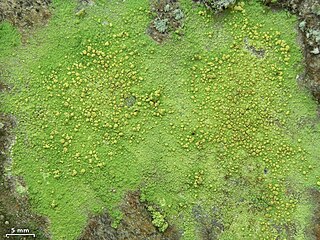
The Pertusariales are an order of fungi in the class Lecanoromycetes, comprising 8 families, 31 genera, and over 600 species, many of which form lichens. This diverse group is characterized by complex taxonomic history and ongoing phylogenetic revisions. Originally proposed by Maurice Choisy in 1949 and later formally published by the lichenologists David L. Hawksworth and Ove Eriksson in 1986, Pertusariales has undergone significant reclassification due to molecular phylogenetics studies. The order includes well-known genera such as Pertusaria and Ochrolechia, as well as families like Megasporaceae and Icmadophilaceae.

The Graphidaceae are a family of lichen-forming fungi in the order Graphidales. The family contains nearly a hundred genera and more than 2000 species. Although the family has a cosmopolitan distribution, most Graphidaceae species occur in tropical regions, and typically grow on bark.

Diploschistes is a genus of lichen-forming fungi in the family Graphidaceae. Commonly known as crater lichens, members of the genus are crustose lichens with a thick, cracked (areolate) body (thallus) with worldwide distribution. The fruiting part (apothecia) are immersed in the thick thallus so as to have the appearance of being small "craters". The widespread genus contains about 43 species.

Psilolechia is a genus of four species of crustose lichens. It is the only member of Psilolechiaceae, a family that was created in 2014 to contain this genus.

Parmotrema is a genus of lichen belonging to the family Parmeliaceae. It is a large genus, containing an estimated 300 species, with a centre of diversity in subtropical regions of South America and the Pacific Islands.

Phacopsis is a genus of lichenicolous (lichen-dwelling) fungi. They are parasites of members of the large lichen family Parmeliaceae, of which they are also a member. Originally proposed by Edmond Tulasne in 1852 to contain 3 species, Phacopsis now contains 10 species, although historically, 33 taxa have been described in the genus. Many of the species are poorly known, some of them having been documented only from the type specimen.
Graphis marusae is a species of corticolous (bark-dwelling) crustose lichen in the family Graphidaceae. It is found in a relict tropical lowland rainforest in Veracruz, Mexico, growing in exposed understory.

Solenopsora is a genus of lichen-forming fungi in the family Catillariaceae. It has 15 species, with a mostly Northern Hemisphere distribution.

Schaereria is a genus of lichen-forming fungi. It is the sole genus in the family Schaereriaceae, which itself is the only family in the Schaereriales, an order in the subclass Ostropomycetidae of the class Lecanoromycetes. Most Schaereria species are crustose lichens that live on rocks. Schaereria was first proposed by Gustav Wilhelm Körber in 1855 and was later taken up by other lichenologists despite periods of disuse.

Pyrenodesmia is a genus of lichen-forming fungi in the family Teloschistaceae. The genus currently includes 23 recognized species but is believed to contain many more unnamed taxa. The genus was circumscribed in 1852 by Italian lichenologist Abramo Bartolommeo Massalongo. It is characterised by the complete absence of anthraquinones and the presence of Sedifolia-gray pigments in both the thallus and apothecia. These lichens are typically found in calcareous outcrops in the Northern Hemisphere, with biodiversity centres in the Mediterranean basin, Central Asia, and arid regions of western North America.
Celotheliaceae is a family of fungi in the monotypic order Phaeomoniellales. It contains 27 species of crustose lichens with thalli that are more or less immersed in tree bark.

Parmotrema perforatum, commonly known as the perforated ruffle lichen, is a species of foliose lichen in the family Parmeliaceae. The lichen was first formally described as new species in 1787 by Nikolaus Joseph von Jacquin. It was transferred to the genus Parmotrema by Italian lichenologist Abramo Bartolommeo Massalongo in 1860. The lichen is characterized by its apothecia often having a perforated hole in the center. The genus Parmotrema has a naked (white) zone on the underside margin and often has long hair-like projections on the lobe edges called cilia; P. perforatum is no different. The thallus is gray and lacks the yellow-green tones that is seen in lichens with usnic acid. There are no asexual structures, but there are apothecia that have the characteristic hole in the center.
Nitidochapsa is a genus of lichen-forming fungi in the family Graphidaceae. It has five species of corticolous (bark-dwelling), crustose lichens.

Pyrenodesmia variabilis is a species of saxicolous (rock-dwelling), crustose lichen in the family Teloschistaceae. Characteristics of the species include its dark, areolate thallus, and its dark, sessile (stalkless) apothecia. It occurs on nutrient-rich limestone surfaces in Northern Europe, North America, Central America, and Asia.
Pseudotopeliopsis is a genus of lichen-forming fungi in the family Graphidaceae. It has two species.

Mangoldia is a genus of lichen-forming fungi in the subfamily Graphidoideae of the family Graphidaceae. It contains four species of corticolous (bark-dwelling) script lichens.
Melanotopelia is a genus of lichen-forming fungi in the family Graphidaceae. It has four species of corticolous (bark-dwelling), crustose lichens. This genus includes species characterised by dark pigmentation in their exciple, non-amyloid ascospores, and specific secondary metabolites.
Crocynia is a genus of lichen-forming fungi in the family Ramalinaceae. It has five species. The genus is currently in taxonomic limbo because molecular studies have shown that Crocynia, which has nomenclatural priority over Phyllopsora, is phylogenetically nested within Phyllopsora. This has led to a proposal to conserve the name Phyllopsora over Crocynia to ensure nomenclatural stability and avoid taxonomic disarray.
Sparria is a small genus of lichen-forming fungi in the family Opegraphaceae.











